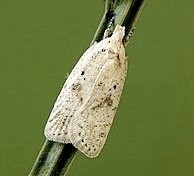Hemlock moth
(Agonopterix alstroemeriana)

Description
The hemlock moth (Agonopterix alstroemeriana), also known as the defoliating hemlock moth or poison hemlock moth, is a nocturnal moth species of the family Depressariidae. Of Palaearctic origin, it was first found in North America in 1973 when it was accidentally introduced. The moth is now widespread throughout the northern half of the United States, southern Canada, northern Europe, and, more recently, New Zealand and Australia. The larval form grows to around 10 mm, while the adults wingspan is between 17 mm and 19 mm. It is best known for its use in biological control of the lethally toxic poison hemlock (Conium maculatum), which is eaten by its caterpillars (larvae). The toxicity of its host plant may actually benefit the caterpillar because it helps females recognize locations for oviposition. This species also uses the leaves of its host plant (C. maculatum) to form protective tubes around the caterpillar. Adult moths are pale brown, almost tan, with a lighter colored area near the bottom of their wings and a few darker spots found near the edges of the wings. They have a distinguishing brown or reddish spot near the center of each wing. The hemlock moth can be confused with another moth of the family Depressariidae, Exaeretia canella, which is similar in coloration. However, E. canella does not have a reddish spot, and has a dark head. As eggs, they have a pale, off-white color. As caterpillars, they are yellow with a black head. After growing in size (to around 10 mm), the caterpillars are thin and have a light green color, with three prominent stripes on the sides of their bodies, which are a darker green. A. alstroemeriana is a wide-ranging species native to Europe, that has more recently spread to North America, Australian and New Zealand. In North America, it is most common to the northeastern and northwestern United States, as well as the southern regions of Canada. It has spread inland in both nations, and can now commonly be found in the Midwestern states of the U.S. as well. The first North American sighting of the hemlock moth was of a caterpillar seen in Tompkins County, New York in 1973. After that, Agonopterix alstroemeriana spread quickly throughout the United States. It was found in the Pacific Northwest in 1983–1985, possibly spread by the accidental shipping of dormant moths. The moth was seen in the Midwest starting in 1990, when it was discovered near Columbus, Ohio.
Taxonomic tree:







